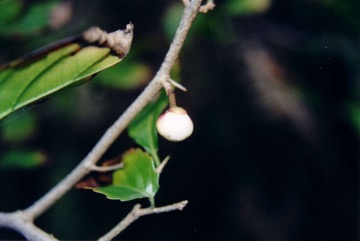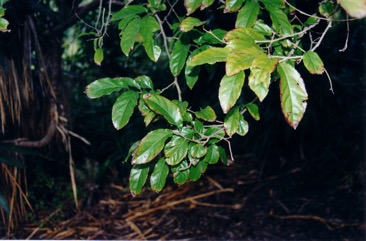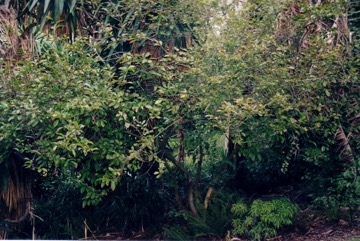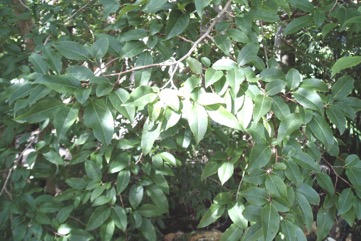Fried egg tree, Snuff-box tree

A tropical plant. It is native to Arabia and tropical Africa. It occurs over a wide range of altitudes. It grows in open woodland and among rocks and along rivers. It is often an under-storey tree in the forest. It does best in full sun but can tolerate light shade. It has some salt tolerance but cannot tolerate strong winds. In Malawi it grows up to 900 m altitude. In Ethiopia it grows between 690-2,350 m above sea level. It grows in areas with an annual rainfall of 550 mm and above. It can grow in arid places. It grows in Miombo woodland in Africa. Melbourne Botanical Gardens. It suits hardiness zones 9-12.
Also known as:
Adiquala, Asratoa, Ebola, Hagila, Hagile, Iedloro, Ithongwane, Jibo, Kaposo, Katwa, Kokochiko, Lenonya badimo, Mahela, Marsalo, Mdara, Mduvi, Miseche, Msebeye, Msewe, Msuguswa, Mtawa, Mtonga, Mununzu, Munzenze, Musangosango, Musanguina, Mushwawo, Musombo, Mutuzu, Mutudzwi, Nehowana, Olboldoli, Olsanangurugi, Oncob, Onkob, Pohon kotak cerutu, Sewe, Sewembulko, Tongwaan, Ula, Umtfongwane, Umthumgwa, Umtongwane
Synonyms
- Oncoba monacantha Steud.
Edible Portion
- Fruit, Seeds - oil
Where does Fried egg tree grow?
Found in: Africa, Angola, Arabia, Asia, Australia, Botswana, Burkina Faso, Cameroon, Central Africa, Chad, Congo, Côte d'Ivoire, East Africa, Egypt, Eswatini, Ethiopia, Ghana, Guinea, Guinée, Guinea-Bissau, India, Indonesia, Ivory Coast, Kenya, Malawi, Mali, Mozambique, Namibia, Nigeria, North Africa, North America, Sao Tome and Principe, Saudi Arabia, SE Asia, Senegal, Sierra Leone, South Africa, Southern Africa, Sri Lanka, Swaziland, Tanzania, Togo, Uganda, United States, West Africa, Yemen, Zambia, Zimbabwe
Status: The pulp of the fruit is edible but not popular. They are eaten especially by boys and children. They are a famine food.
Growing Fried egg tree, Snuff-box tree
Cultivation: Plants are grown from seed. It can also be grown from cuttings. It can be grown as a hedge.
Edible Uses: The pulp of the fruit is eaten raw. The seeds are discarded. The seeds yield an edible oil.
Production: It is slow growing. In Tanzania fruit are collected from April to June.
Nutrition Info
per 100g edible portion| Edible Part | Energy (kcal) | Protein (g) | Iron (mg) | Vitamin A (ug) | Vitamin c (mg) | Zinc (mg) | % Water |
|---|---|---|---|---|---|---|---|
| - | - | - | - | - | - |
Fried egg tree, Snuff-box tree Photos





References
Abbiw, D.K., 1990, Useful Plants of Ghana. West African uses of wild and cultivated plants. Intermediate Technology Publications and the Royal Botanic Gardens, Kew. p 47
Ambasta, S.P. (Ed.), 2000, The Useful Plants of India. CSIR India. p 408
Arora, R. K., 2014, Diversity in Underutilized Plant Species - An Asia-Pacific Perspective. Bioversity International. p 79
Asfaw, Z. and Tadesse, M., 2001, Prospects for Sustainable Use and Development of Wild Food Plants in Ethiopia. Economic Botany, Vol. 55, No. 1, pp. 47-62
Atato, A., et al, 2010, Diversity of Edible Wild Fruit Tree Species of Togo. Global Science Books.
Awas, T., 1997, A Study on the Ecology and Ethnobotany of Non-cultivated Food Plants and Wild Relatives of Cultivated crops in Gambella Region, Southwestern Ethiopia. Addis Ababa University. p 53
Balemie, K., & Kebebew, F., 2006, Ethnobotanical study of wild edible plants in Derashe and Kucha Districts, South Ethiopia. Journal of Ethnobiology and Ethnomedicine.
Barwick, M., 2004, Tropical and Subtropical Trees. A Worldwide Encyclopedic Guide. Thames and Hudson p 302
Berihun, T. & Molla, E., 2017, Study on the Diversity and Use of Wild Edible Plants in Bullen District Northwest Ethiopia. Hindawi Journal of Botany. Article ID 8383468
Burkill, H. M., 1985, The useful plants of west tropical Africa, Vol. 2. Kew.
Cundall, P., (ed.), 2004, Gardening Australia: flora: the gardener's bible. ABC Books. p 952
Ethiopia: Famine Food Field Guide. http://www.africa.upenn.edu/faminefood/category3.htm
Facciola, S., 1998, Cornucopia 2: a Source Book of Edible Plants. Kampong Publications, p 117
Fl. aegypt.-arab. cxiii, 103. 1775
Fowler, D. G., 2007, Zambian Plants: Their Vernacular Names and Uses. Kew. p 59
Fox, F. W. & Young, M. E. N., 1982, Food from the Veld. Delta Books. p 231
Goode, P., 1989, Edible Plants of Uganda. FAO p 30
Gueye, M., et al, 2014, Wild Fruits Traditionally Gathered by the Malinke Ethnic Group in the Edge of Niokolo Koba Park (Senegal). American Journal of Plant Sciences 5, 1306-1317
Hedrick, U.P., 1919, (Ed.), Sturtevant's edible plants of the world. p 448
Heywood, V.H., Brummitt, R.K., Culham, A., and Seberg, O. 2007, Flowering Plant Families of the World. Royal Botanical Gardens, Kew. p 149
Hibbert, M., 2002, The Aussie Plant Finder 2002, Florilegium. p 213
Jardin, C., 1970, List of Foods Used In Africa, FAO Nutrition Information Document Series No 2.p 150
Joffe, P., 2007, Creative Gardening with Indigenous Plants. A South African Guide. Briza. p 235
Keay, R.W.J., 1989, Trees of Nigeria. Clarendon Press, Oxford. p 59
Kebebew, M. & Leta, G., 2016, Wild Edible Plant Bio-diversity and Utilization System in Nech Sar National Park, Ethiopia. International Journal of Bio-resource and Stress Management 2016, 7(4):885-896
Kidane, B., et al, 2014, Ethnobotany of Wild and Semi-wild Edible Fruit Species used by Maale and Ari Ethnic Communities in South Ethiopia. Ethnobotany Research and Applications. Vol. 12, 1546-3465-12-455
Llamas, K.A., 2003, Tropical Flowering Plants. Timber Press. p 224
Long, C., 2005, Swaziland's Flora - siSwati names and Uses http://www.sntc.org.sz/flora/
Lovett, J. C. et al, Field Guide to the Moist Forest Trees of Tanzania. p 62
Lulekal, E., et al, 2011, Wild edible plants in Ethiopia: a review on their potential to combat food insecurity. Afrika Focus - Vol. 24, No 2. pp 71-121
Lyle, S., 2006, Discovering fruit and nuts. Land Links. p 302
Macmillan, H.F. (Revised Barlow, H.S., et al) 1991, Tropical Planting and Gardening. Sixth edition. Malayan Nature Society. Kuala Lumpur. p 305
Malaisse, F., 1997, Se nourrir en floret claire africaine. Approche ecologique et nutritionnelle. CTA., p 65
Masters, T., 2021, Traditional food plants of the upper Aswa River catchment of northern Uganda—a cultural crossroads. Journal of Ethnobiology and Ethnomedicine (2021) 17:24
Morley, B. & Everard, B., 1970, Wild Flowers of the World. Ebury press. Plate 59
Msuya, T. S., et al, 2010, Availability, Preference and Consumption of Indigenous Foods in the Eastern Arc Mountains, Tanzania, Ecology of Food and Nutrition, 49:3, 208-227
Ojelel, S., et al, 2019, Wild edible plants used by communities in and around selected forest reserves of Teso-Karamoja region, Uganda. Journal of Ethnobiology and Ethnomedicine (2019) 15:3
Palgrave, K.C., 1996, Trees of Southern Africa. Struik Publishers. p 624
Palmer, E and Pitman, N., 1972, Trees of Southern Africa. Vol. 3. A.A. Balkema, Cape Town p 1537
Peters, C. R., O'Brien, E. M., and Drummond, R.B., 1992, Edible Wild plants of Sub-saharan Africa. Kew. p 114
Roodt, V., 1998, Trees & Shrubs of the Okavango Delta. Medicinal Uses and Nutritional value. The Shell Field Guide Series: Part 1. Shell Botswana. p 195
Royal Botanic Gardens, Kew (1999). Survey of Economic Plants for Arid and Semi-Arid Lands (SEPASAL) database. Published on the Internet; http://www.rbgkew.org.uk/ceb/sepasal/internet [Accessed 16th April 2011]
Ruffo, C. K., Birnie, A. & Tengnas, B., 2002, Edible Wild Plants of Tanzania. RELMA p 496
Ruiters-Welcome, A. K., 2019, Food plants of southern Africa. Ph.D. thesis. Univ. of Johannesburg p 99
Schmidt, E., Lotter, M., & McCleland, W., 2007, Trees and shrubs of Mpumalanga and Kruger National Park. Jacana Media p 432
Storrs, A. E. C., 1995 reprint, Know Your Trees. Some Common Trees found in Zambia, Forestry Division. Regional Soil Conservation Unit, Nairobi, p 57
Sukarya, D. G., (Ed.) 2013, 3,500 Plant Species of the Botanic Gardens of Indonesia. LIPI p 423
Swaziland's Flora Database http://www.sntc.org.sz/flora
von Katja Rembold, 2011, Conservation status of the vascular plants in East African rain forests. Dissertation Universitat Koblenz-Landau p 175
White, F., Dowsett-Lemaire, F. and Chapman, J. D., 2001, Evergreen Forest Flora of Malawi. Kew. p 274
Williamson, J., 2005, Useful Plants of Malawi. 3rd. Edition. Mdadzi Book Trust. p 178
World Checklist of Useful Plant Species 2020. Royal Botanic Gardens, Kew
www.zimbabweflora.co.zw 2011